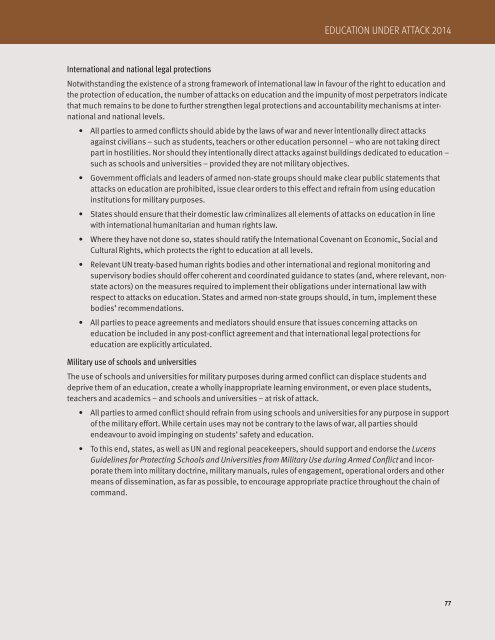eua_2014_full.pdf?utm_content=buffer4a392&utm_medium=social&utm_source=twitter
eua_2014_full.pdf?utm_content=buffer4a392&utm_medium=social&utm_source=twitter
eua_2014_full.pdf?utm_content=buffer4a392&utm_medium=social&utm_source=twitter
- No tags were found...
You also want an ePaper? Increase the reach of your titles
YUMPU automatically turns print PDFs into web optimized ePapers that Google loves.
EDUCATION UNDER ATTACK <strong>2014</strong>International and national legal protectionsNotwithstanding the existence of a strong framework of international law in favour of the right to education andthe protection of education, the number of attacks on education and the impunity of most perpetrators indicatethat much remains to be done to further strengthen legal protections and accountability mechanisms at inter -national and national levels.• All parties to armed conflicts should abide by the laws of war and never intentionally direct attacksagainst civilians – such as students, teachers or other education personnel – who are not taking directpart in hostilities. Nor should they intentionally direct attacks against buildings dedicated to education –such as schools and universities – provided they are not military objectives.• Government officials and leaders of armed non-state groups should make clear public statements thatattacks on education are prohibited, issue clear orders to this effect and refrain from using educationinstitutions for military purposes.• States should ensure that their domestic law criminalizes all elements of attacks on education in linewith international humanitarian and human rights law.• Where they have not done so, states should ratify the International Covenant on Economic, Social andCultural Rights, which protects the right to education at all levels.• Relevant UN treaty-based human rights bodies and other international and regional monitoring andsupervisory bodies should offer coherent and coordinated guidance to states (and, where relevant, nonstateactors) on the measures required to implement their obligations under international law withrespect to attacks on education. States and armed non-state groups should, in turn, implement thesebodies’ recommendations.• All parties to peace agreements and mediators should ensure that issues concerning attacks oneducation be included in any post-conflict agreement and that international legal protections foreducation are explicitly articulated.Military use of schools and universitiesThe use of schools and universities for military purposes during armed conflict can displace students anddeprive them of an education, create a wholly inappropriate learning environment, or even place students,teachers and academics – and schools and universities – at risk of attack.• All parties to armed conflict should refrain from using schools and universities for any purpose in supportof the military effort. While certain uses may not be contrary to the laws of war, all parties shouldendeavour to avoid impinging on students’ safety and education.• To this end, states, as well as UN and regional peacekeepers, should support and endorse the LucensGuidelines for Protecting Schools and Universities from Military Use during Armed Conflict and incorporatethem into military doctrine, military manuals, rules of engagement, operational orders and othermeans of dissemination, as far as possible, to encourage appropriate practice throughout the chain ofcommand.77


